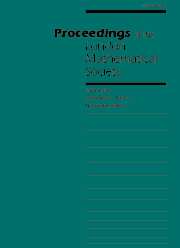Article contents
Exponential sums and the Riemann zeta function v
Published online by Cambridge University Press: 16 December 2004
Abstract
A Van der Corput exponential sum is $S = \Sigma \exp (2 \pi i f(m))$, where $m$ has size $M$, the function $f(x)$ has size $T$ and $\alpha = (\log M) / \log T < 1$. There are different bounds for $S$ in different ranges for $\alpha $. In the middle range where $\alpha $ is near ${1\over 2}$, $S = O(\sqrt{M} T^{\theta + \epsilon })$. This $\theta $ bounds the exponent of growth of the Riemann zeta function on its critical line ${\rm Re} s = {1\over 2}$. Van der Corput used an iteration which changed $\alpha$ at each step. The Bombieri–Iwaniec method, whilst still based on mean squares, introduces number-theoretic ideas and problems. The Second Spacing Problem is to count the number of resonances between short intervals of the sum, when two arcs of the graph of $y = f'(x)$ coincide approximately after an automorphism of the integer lattice. In the previous paper in this series [Proc. London Math. Soc. (3) 66 (1993) 1–40] and the monograph Area, lattice points, and exponential sums we saw that coincidence implies that there is an integer point close to some ‘resonance curve’, one of a family of curves in some dual space, now calculated accurately in the paper ‘Resonance curves in the Bombieri–Iwaniec method’, which is to appear in Funct. Approx. Comment. Math.
We turn the whole Bombieri–Iwaniec method into an axiomatised step: an upper bound for the number of integer points close to a plane curve gives a bound in the Second Spacing Problem, and a small improvement in the bound for $S$. Ends and cusps of resonance curves are treated separately. Bounds for sums of type $S$ lead to bounds for integer points close to curves, and another branching iteration. Luckily Swinnerton-Dyer's method is stronger. We improve $\theta $ from 0.156140... in the previous paper and monograph to 0.156098.... In fact $(32/205 + \epsilon , 269/410 + \epsilon)$ is an exponent pair for every $\epsilon > 0$.
Keywords
- Type
- Research Article
- Information
- Copyright
- 2004 London Mathematical Society
- 63
- Cited by


